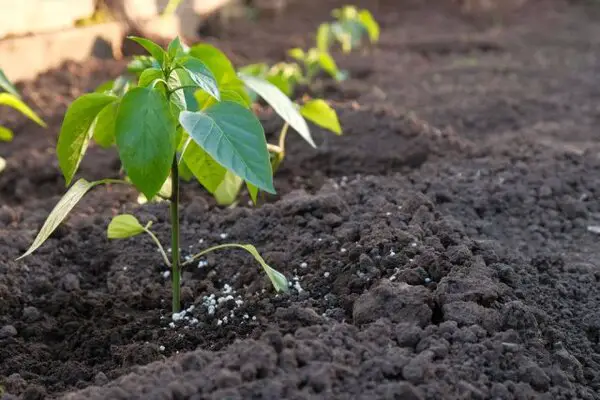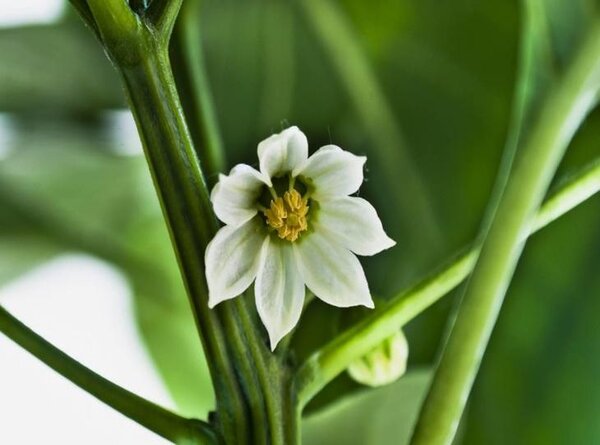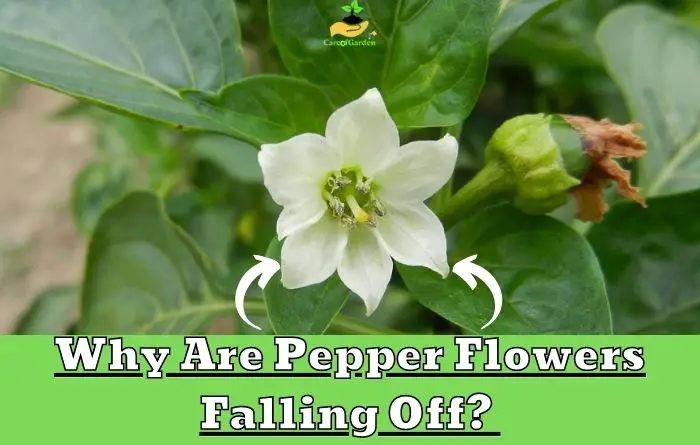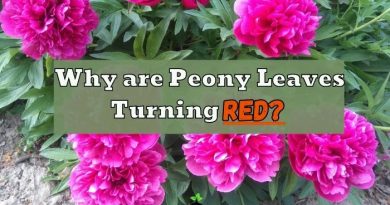Why Are Pepper Flowers Falling Off? Here’s How to Stop It!
Every once in a while when it comes to peppers I’m faced with this issue: flowers are falling off. I know how disappointing it can be to watch your pepper plants lose their flowers before they can produce any fruit. But with some research, and a bit of trial and error, I’ve discovered how to keep those precious pepper flowers on your plants and ensure a successful harvest.
There are several reasons why pepper flowers may be falling off, including over-watering, nutrient deficiencies, and insufficient pollination. Additionally, extreme temperatures and pest infestations can also lead to flower drop. Ensure that the plants are receiving adequate sunlight and water, and consider using a balanced fertilizer sparingly. Additionally, check for nutrient deficiencies in the soil and make any necessary adjustments to the fertilizer or soil composition.
1. Environmental Factors
One of the most common reasons for flower drop is environmental stress. Too little water or too much water, temperature extremes, lack of light or too much sun, all of these can put stress on the plant and cause its flowers to drop off.
Too Little/Too Much Water
Pepper plants often need a consistent supply of water but their roots don’t like to remain in waterlogged soil for too long. When plants are overwatered or underwatered, it results in wilting, yellow leaves and falling flowers.
From my experience, pepper can drop buds from both underfilling and waterlogging. Peppers needs to be watered under the roots 1-2 times a week with warm water at the rate of 15-20 liters per 1 sq.m.
If the plant begins to drop leaves or flowers, this may indicate a lack of moisture. Pepper is known to have a superficial root system, so it needs to be watered often, especially during flowering and fruiting. Watering should be moderate and necessarily regular.
Solution
My recommendation is to water peppers in the morning (before the sun) or in the evening (after it). The ideal solution to the problem is drip irrigation.
At the same time, the soil under the bushes should be moistened to a depth of at least 25-30 cm. However, if the temperature outside the window does not reach 59°F (15°C), watering should be stopped in order to avoid certain crop diseases .
Lack of Sunlight
Due to the fact that in a greenhouse there is low light, pepper flowers can start falling off. Sunlight is required for the process of photosynthesis, which is how plants produce energy to fuel their growth and development. Without enough light, peppers may not have enough energy to support flower and fruit production.
Pepper plants required daylight hours and needs at least 12 hours of light, which stimulates the formation of flowers and ovaries. But the climatic zones in our country do not imply such a long daylight hours, so you need to illuminate with special lamps.
Solution
Experts say that the lighting of pepper is closely related to the air temperature outside the window. So, in the heat (about 86°F/30 °C), the luminous flux should be bright.
But in cloudy weather in summer, the temperature should be kept within 68-72°F (20-22°C).
However, during the heat in bright light, another problem may arise: the plants may fade slightly. You can solve it by providing shelter to the bushes in the form of a light breathable material.
Air Humidity
Since the pepper roots are not deeply embedded in the soil, they do not get the necessary amount of moisture from the soil that they need and that can cause pepper flowers to fall off.
Peppers need to be watered, starting from the period of formation of peduncles and ending with the formation of pepper fruit. At the same time, too dry soil leads to a concentration of salts, and excessive moisture leads to a lack of oxygen. The culture develops well at a humidity of 70-80%.
All kinds of interruptions in watering are reflected in the flowering of the plant, so it is important to take this nuance into account during the flowering period.
Solution
Ideally, air humidity should be at the level of 60-70%. In greenhouse conditions, regular ventilation and appropriate measurements will help to maintain such humidity.
If the humidity level is low (the room is very hot and dry), then it is necessary to install containers with water or spray it on the soil and plants using a sprayer.
Temperature Imbalance
Extreme temperatures can prevent the pollination of pepper flowers and cause them to wilt and drop.
Both an increase in temperature and a decrease can provoke serious problems – the pepper plant begins to drop flowers or get rid of the female flower (ovary). In addition to sudden climatic changes, there are other reasons why pepper ovaries and flowers fall off.
When the temperature decreases, as well as when it increases by only 41°F (5 °C), the pepper flowers begin falling off, and those that remain do not tie.
Adult pepper bushes are more stable, and if the fruits have already set, their ripening can occur at a temperature of 59-61°F (15-16°C), but when it drops to 55°F (13°C), the absorption of useful substances by the root system stops, and the plants begin to die.
This applies to both air and ground temperatures. As a result, you can observe the curling of the leaves of the pepper, as well as the loss of ovaries by the plant.
Solution
To remedy the situation, reduce the difference between day and night temperatures: during the day, ventilate the plantings and install water containers near them, and on cool nights, completely close the greenhouse or install an automatic ventilation system there.
In the open field, cover the pepper plant at night.
Ideal temperatures for pollination range from 65-85°F, with temperatures below 50°F greatly reducing pollination.
2. Excess use of Fertilizers

Usually, the problem begins at the very beginning of spring, when gardeners make a lot of mistakes in the process of sowing pepper seedlings in open ground. They apply a large amount of fertilizer at the sowing stage, which negatively affects the blossom of this vegetable.
Your peppers may go into shock if you fertilize them excessively, which will likely result in dropped flowers. Peppers focus all of their energy on growing foliage rather than a flower that will eventually develop into a fruit.
When there is too much nitrogen in the soil, it can cause the pepper plant to produce more leaves and stems at the expense of flowers and fruit.
This is because nitrogen promotes vegetative growth, and an excess of it can cause the plant to focus on growing foliage rather than producing flowers and fruit.
In addition, too much fertilizer can also lead to salt buildup in the soil, which can cause root damage and further reduce the plant’s ability to take up nutrients.
In order to ensure a high yield, many gardeners regularly feed bushes with different fertilizers.
They only partially succeed in their mission because several dozen flowers can grow on a single branch, but it is obvious that the bush cannot support that many fruits. And because the plant is aware of this, it starts to drop more flowers.
Solution
If you suspect that your pepper plants have been over-fertilized, there are a few steps you can take to help mitigate the damage:
- Avoid fertilizing: To give your pepper plants time to recover, avoid fertilizing for a few weeks or until you see signs of new growth.
- Flush the soil: Excessive fertilizer salts can build up in the soil and harm plant roots. To flush the soil, water your plants deeply and thoroughly until water flows out of the drainage holes in the bottom of the container or onto the soil surface. Repeat this process several times to help remove excess salts.
It’s important to use fertilizers according to the manufacturer’s instructions and to avoid over-fertilizing peppers. It’s also important to conduct soil tests regularly to determine the nutrient levels in the soil and adjust fertilization accordingly.
3. Nutrient Deficiencies
If you’re under fertilizing your pepper plants, it can cause them to drop their flowers as a result of nutrient deficiency.
When there is an inadequate supply of phosphorus, potassium, magnesium and other trace minerals, the plant becomes stressed, which causes poor flower formation and development.
A lack of vital nutrients such as nitrogen, potassium and phosphorus can cause plants to produce fewer blossoms or even no blossoms at all.
The addition of compost or fertilizer often helps alleviate nutrient deficiency problems if used properly according to the product instructions.
| Nutrient Deficiency | Symptoms | Treatment |
|---|---|---|
| Calcium | Blossom end rot, where the bottom of the pepper turns black and leathery, causing flowers to fall off. | Apply calcium-rich fertilizers such as bone meal or gypsum to the soil. Maintain consistent soil moisture levels. |
| Boron | Reduced flower formation, premature flower drop, distorted growth | Apply boron-rich fertilizers such as borax or boric acid to the soil. Be careful not to over-apply, as boron toxicity can occur. |
| Magnesium | Yellowing of leaves and premature flower fall off. | Apply magnesium-rich fertilizers such as Epsom salt or dolomite lime to the soil. |
| Phosphorus | Stunted growth, weak stems, and flower drop. | Apply phosphorus-rich fertilizers such as rock phosphate or bone meal to the soil. |
| Potassium | Yellowing of leaves, weak stems, and flower drop. | Apply potassium-rich fertilizers such as wood ash or potassium sulfate to the soil. Maintain consistent soil moisture levels. |
| Zinc | Reduced flower formation, premature flower fall, small leaves. | Apply zinc sulfate to the soil or as a foliar spray. Use caution, as excess zinc can be toxic to plants. |
Solution
To prevent nutrient deficiencies from causing pepper flower drop:
- Monitor your soil’s pH level: Make sure to test your soil at least once a year to check its pH. If it’s too low or too high, add amendments to adjust it accordingly.
- Choose the right fertilizer: You need a fertilizer that contains all the essential nutrients your pepper plants need. A fertilizer with a low nitrogen content will be better for flowering peppers since too much nitrogen may cause excessive leaf growth before flowers form.
- Apply the right amount of fertilizer: It’s easy to overdo it when it comes to fertilizing peppers. Make sure you always follow the label instructions! Too much fertilizer can damage plants and increase pepper flower drop.
4. Improper Pollination

Pollination is an essential part of the life cycle of peppers, and if it does not take place properly then it could be one of the main causes behind pepper flowers falling off.
The process of pollination occurs when pollen from the male flower moves to the female flower, which triggers fertilization and eventually leads to fruit formation.
If the pollen does not move from the male flower to the female or if pollinators like bees, butterflies, or hummingbirds do not visit the flowers, then pepper flowers can fall off before they get a chance to form fruit.
The ovaries may fall off due to the weak activity of the insects that pollinate the plant in bad weather. To prevent this from happening, you need to apply an agricultural technique – this is shaking a branch with flowers in the morning.
Solution
The lack of honeybees or other beneficial insects needed for successful pollination can result in fewer blossoms and flowers falling.
The presence of too many pests such as aphids, spider mites, or caterpillars can also deter beneficial insects from visiting the garden.
Increase pollinator visitation by:
- Planting more native flowering plants that attract pollinators
- Providing shelter and water sources to attract and retain these beneficial insects in your garden
- Reducing pesticide use in your garden
- Adding bee boxes or nesting sites specifically for bees
- Planting a mix of tall and short flowering plants to make it easier for pollinators to access all the flowers in your garden.
By increasing pollinator visitation in your garden, you can help ensure that peppers will receive proper pollination and reduce the likelihood of pepper flowers falling off before they have a chance to turn into fruit.
To get a good harvest of pepper, you need to pay attention to seedlings. So it is recommended to plant in mid-May, during the period of complete absence of frost.
5. Pests and Diseases
Parasitic insects and pathogenic microorganisms are much less likely to cause the fall of flowers and ovaries, but this reason should also be considered. Pests and diseases such as aphids, mites, fungi, and viruses all have the potential to cause pepper flowers to drop off the plant.
Aphids
Aphids feed off the sap from pepper plants, often eating away at young flower buds. This can prevent flowers from forming or cause them to fall off after they have bloomed.
To control aphids, regularly check for infestations and use an insecticidal soap or a neem oil solution.
Mites
Mites are a common pest for pepper plants, leaving small yellow spots on the leaves which can then lead to flower falling off. The best way to control mites is to introduce predatory insects such as ladybugs into your garden that will eat away at the pests without damaging your pepper plants.
Fungi
Fungal diseases such as powdery mildew can cause yellowing of leaves and eventual flower drop when left untreated.
Keeping your soil well-drained and planting in sunny areas are two methods of preventing fungal infections before they start. If infection occurs, spraying your plant with a fungicide should help eliminate it quickly.
Viruses
Viruses such as mosaic virus can penetrate through wounded plant tissue leading to wilting and eventual death of the pepper flowers due to lack of nutrients.
The only surefire way to protect against viruses is prevention: practice good hygiene by keeping tools sanitized and dispose of any infected plants immediately upon detection.
How to Prevent Pepper Flower Drop: Solutions and Care Tips
Do you want to prevent pepper flower drop? Then you’re in luck! There are many things you can do to ensure that your pepper flowers will remain on the plant, rather than falling off.
1.Water and Fertilizer
Ensure that your pepper plants are getting the ideal amount of water and fertilizer. Water your pepper plants once or twice a week for about 20 minutes each.
Deep watering technique helps to encourage good root development. The ideal fertilizer mix is a slow-release one with balanced nitrogen, potassium, and phosphorous levels.
2. Start Pruning
It’s important to prune away any dead or weak branches, as well as any that might be competing with other branches for light or other resources.
Pruning will help to open up the canopy of your pepper plants and allow more sunlight to reach all parts of it. This will also help promote healthy growth, which could potentially lead to more flowers.
3. Planting Method
While planting pepper plants in containers, avoid planting them too deeply in the soil. Make sure there is suitable amount of space between the soil and the base of the stem.
This will help ensure that there is ample air circulation around the stem and roots, which can help prevent flower drop due to fungal diseases.
Conclusion
The reasons for dropping the ovaries and flowers of peppers can be very different, but they can be eliminated by following the simple solutions that I showed you in this article.
Most often, the problem is caused by improper care. It is important to follow the basics of pepper care; this will ensure the growth and active fruiting of the crop.




